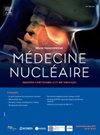Optimization of the management of hemodialyzed patients treated with 131I radioiodine for thyroid cancer: The Lille experience
IF 0.2
4区 医学
Q4 PATHOLOGY
Medecine Nucleaire-Imagerie Fonctionnelle et Metabolique
Pub Date : 2025-03-01
DOI:10.1016/j.mednuc.2025.01.185
引用次数: 0
Abstract
Background & objectives
The use of 131I radioiodine (RAI) for patients with thyroid cancer (TC) also treated with hemodialysis for end stage renal disease (HD-ESRD) remains challenging, with several issues still poorly known: adaptation of RAI activity and previous preparation, estimation of bone marrow (BM) absorbed dose, impact of dialysis parameters, oncological outcome and toxicity risk. We wanted to report our tertiary referral center experience and suggestions for improvement regarding these points.
Material & methods
We included all HD-ESRD patients that required RAI for TC in our institution. Oncological results and toxicity risk were evaluated. BM absorbed dose was estimated based on current guidelines and compared with two optimized models that took account the variability observed in HD patients. We simulated the impact of high RAI activity on BM-absorbed dose. Dialysis parameters were reviewed to correlate with kinetics of RAI activity. The impact of two different schema of rhTSH was also studied.
Results
Sixteen patients were included. Fifteen patients were prepared with rhTSH (5 with one injection on D-2, 10 with two injections on D-10/D-2). Median RAI activity was 2913 MBq, immediate and late tolerance was good. Median BM absorbed dose was 0.72 Gy; 0.81 Gy and 0.67 Gy with models 1; 2 and 3 respectively, statistically different between all groups. There was no significant correlation between the decrease in blood activity and purified blood volume per dialysis session neither total purified blood volume. No patient would have crossed the 2 Gy threshold with a delivered activity of 3700MBq.
Conclusion
Based on the largest series of HD-ESRD patients treated with RAI for TC, we present findings that could enhance their management. Our dosimetry models provide a more accurate reflection of biological reality, making them valuable for planning dosimetry. Our simulations suggest that routine reductions in RAI activity may be overly cautious and unnecessary. Oncological outcomes were favorable, without cancer-related deaths or significant hematological toxicity. A target of 65–70 liters of purified blood volume per session results in over 90% reduction in radioactivity after two dialysis sessions. Two rhTSH injections at D-10/D-2 before RAI may be a viable alternative to hormone withdrawal.
优化甲状腺癌 131I 放射性碘治疗的血液透析患者的管理:里尔的经验
背景,在接受终末期肾病(HD-ESRD)血液透析治疗的甲状腺癌(TC)患者中使用131I放射性碘(RAI)仍然具有挑战性,有几个问题仍然知之甚少:RAI活性的适应和先前的准备,骨髓(BM)吸收剂量的估计,透析参数的影响,肿瘤学结局和毒性风险。我们想报告我们的三级转诊中心的经验和建议,以改善这些点。材料,方法我们纳入了我院所有需要进行TC RAI的HD-ESRD患者。评估肿瘤结果和毒性风险。BM的吸收剂量是根据目前的指南估计的,并与考虑到HD患者中观察到的可变性的两种优化模型进行比较。我们模拟了高RAI活性对脑吸收剂量的影响。回顾了透析参数与RAI活性动力学的关系。研究了两种不同模式对rhTSH的影响。结果共纳入16例患者。15例患者注射rhTSH(5例D-2注射一次,10例D-10/D-2注射两次)。RAI活性中位数为2913 MBq,即时和后期耐受性良好。BM中位吸收剂量为0.72 Gy;模型1为0.81 Gy和0.67 Gy;2、3,组间差异有统计学意义。血液活性的降低与每次透析的纯化血容量之间没有显著的相关性,也没有总纯化血容量。没有患者会在传递活动为3700MBq的情况下超过2 Gy阈值。结论基于最大的HD-ESRD患者系列,采用RAI治疗TC,我们提出了可以加强其管理的发现。我们的剂量学模型更准确地反映了生物现实,使它们对计划剂量学有价值。我们的模拟表明,常规减少RAI活动可能过于谨慎和不必要。肿瘤预后良好,无癌症相关死亡或显著血液学毒性。每次透析65-70升纯化血容量的目标导致两次透析后放射性降低90%以上。RAI前在D-10/D-2注射两次rhTSH可能是激素停药的可行替代方案。
本文章由计算机程序翻译,如有差异,请以英文原文为准。
求助全文
约1分钟内获得全文
求助全文
来源期刊
CiteScore
0.30
自引率
0.00%
发文量
160
审稿时长
19.8 weeks
期刊介绍:
Le but de Médecine nucléaire - Imagerie fonctionnelle et métabolique est de fournir une plate-forme d''échange d''informations cliniques et scientifiques pour la communauté francophone de médecine nucléaire, et de constituer une expérience pédagogique de la rédaction médicale en conformité avec les normes internationales.

 求助内容:
求助内容: 应助结果提醒方式:
应助结果提醒方式:


